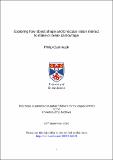Files in this item
Exploring how object shape and binocular vision interact to make or break camouflage
Item metadata
| dc.contributor.advisor | Harris, Julie | |
| dc.contributor.author | Cammack, Philip | |
| dc.coverage.spatial | 227 p. | en_US |
| dc.date.accessioned | 2018-12-04T15:31:54Z | |
| dc.date.available | 2018-12-04T15:31:54Z | |
| dc.date.issued | 2017-06-20 | |
| dc.identifier.uri | https://hdl.handle.net/10023/16624 | |
| dc.description.abstract | Depth perception is a major component of 3D vision. There are many cues to depth; one particularly sensitive aspect is the vivid perception of depth created from having eyes with overlapping visual fields (binocular vision). As the eyes are located at different points in space, they see different views of the scene – these slight differences (called binocular disparity) can be used to obtain depth information. However, extracting depth from disparity requires complex visual processing. So why use binocular vision? Julesz (1971) proposed an explanation – camouflaged animals can fool the perception of some cues to 3D shape, but camouflage is ineffective against binocular vision. We would expect that animals with binocular vision could see the 3D shape of animals, despite their camouflage. Whilst commonly accepted, this hypothesis has not been tested in detail. In this thesis, we present experiments designed to establish how depth from binocular vision interacts with camouflage and object shape. Two main questions were addressed: First, we explored how the visual system represented depth information about 3D objects from binocular disparity. Objects with smooth depth edges (hill-shaped) were perceived with less depth than sharper edged objects. A computational model that segregated the object, then averaged the disparity over the segregated region emulated human performance. Finally, we found that disparity and luminance cues interacted to alter perceived depth. Secondly, we investigated if binocular vision could overcome camouflage. We found that camouflaged objects defined by luminance were detected faster when also defined by depth from disparity, thus reduces the effect of camouflage. Smooth objects were detected slower than sharp objects: an effect that was replicated in the real world, suggesting a camouflage technique to counter binocular vision. In summary, binocular vision is useful because it can detect camouflaged objects. However, smoother shapes take longer to spot, forming binocular (or stereoscopic) camouflage. | en |
| dc.language.iso | en | en_US |
| dc.publisher | University of St Andrews | |
| dc.subject.lcc | BF469.C26 | |
| dc.subject.lcsh | Depth perception | en |
| dc.subject.lcsh | Movement, Psychology of | en |
| dc.subject.lcsh | Camouflage (Biology) | en |
| dc.title | Exploring how object shape and binocular vision interact to make or break camouflage | en_US |
| dc.type | Thesis | en_US |
| dc.contributor.sponsor | Engineering and Physical Sciences Research Council (EPSRC) | en_US |
| dc.contributor.sponsor | University of St Andrews | en_US |
| dc.contributor.sponsor | University of St Andrews. School of Psychology and Neuroscience | en_US |
| dc.contributor.sponsor | Biotechnology and Biological Sciences Research Council (BBSRC) | en_US |
| dc.type.qualificationlevel | Doctoral | en_US |
| dc.type.qualificationname | PhD Doctor of Philosophy | en_US |
| dc.publisher.institution | The University of St Andrews | en_US |
This item appears in the following Collection(s)
Items in the St Andrews Research Repository are protected by copyright, with all rights reserved, unless otherwise indicated.

